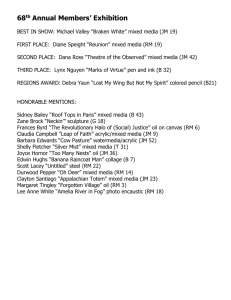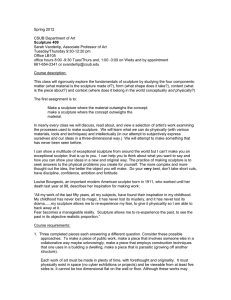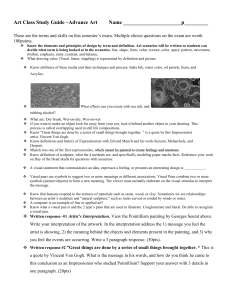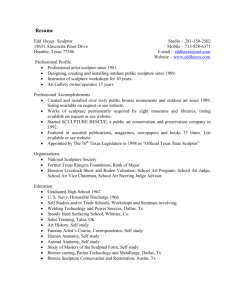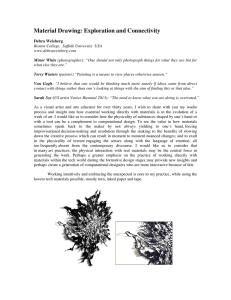Syllabus
advertisement
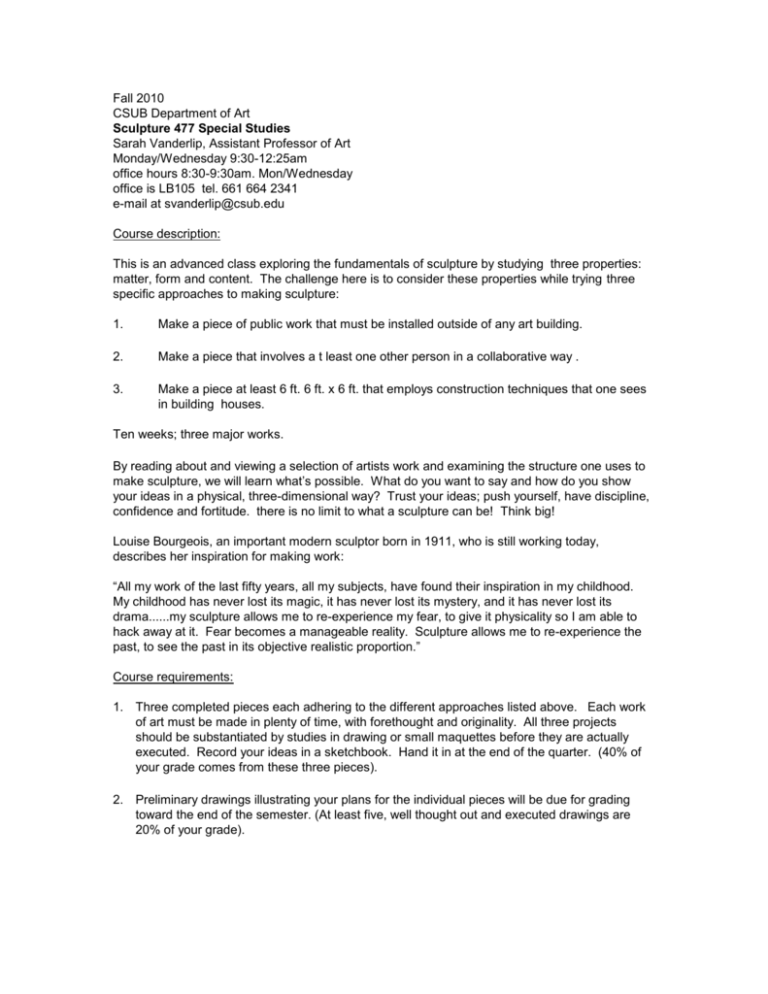
Fall 2010 CSUB Department of Art Sculpture 477 Special Studies Sarah Vanderlip, Assistant Professor of Art Monday/Wednesday 9:30-12:25am office hours 8:30-9:30am. Mon/Wednesday office is LB105 tel. 661 664 2341 e-mail at svanderlip@csub.edu Course description: This is an advanced class exploring the fundamentals of sculpture by studying three properties: matter, form and content. The challenge here is to consider these properties while trying three specific approaches to making sculpture: 1. Make a piece of public work that must be installed outside of any art building. 2. Make a piece that involves a t least one other person in a collaborative way . 3. Make a piece at least 6 ft. 6 ft. x 6 ft. that employs construction techniques that one sees in building houses. Ten weeks; three major works. By reading about and viewing a selection of artists work and examining the structure one uses to make sculpture, we will learn what’s possible. What do you want to say and how do you show your ideas in a physical, three-dimensional way? Trust your ideas; push yourself, have discipline, confidence and fortitude. there is no limit to what a sculpture can be! Think big! Louise Bourgeois, an important modern sculptor born in 1911, who is still working today, describes her inspiration for making work: “All my work of the last fifty years, all my subjects, have found their inspiration in my childhood. My childhood has never lost its magic, it has never lost its mystery, and it has never lost its drama......my sculpture allows me to re-experience my fear, to give it physicality so I am able to hack away at it. Fear becomes a manageable reality. Sculpture allows me to re-experience the past, to see the past in its objective realistic proportion.” Course requirements: 1. Three completed pieces each adhering to the different approaches listed above. Each work of art must be made in plenty of time, with forethought and originality. All three projects should be substantiated by studies in drawing or small maquettes before they are actually executed. Record your ideas in a sketchbook. Hand it in at the end of the quarter. (40% of your grade comes from these three pieces). 2. Preliminary drawings illustrating your plans for the individual pieces will be due for grading toward the end of the semester. (At least five, well thought out and executed drawings are 20% of your grade). 3. Class participation and critical attention to the assignments is essential to the success of the class. Enjoy the critiques; engage yourself. Thoughtful study of each other’s work only informs what you’re working on. Use me and each other for feedback on your projects. (10 % of your grade) 4. Presentation of drawings and ideas during individual meetings with the professor are a big part of the class structure and help students develop their ideas and visual language. Take these meeting seriously and be prepared. There will be approximately three of these meetings. (10% of your grade). 5. Attendance in and out of class is required. Come to class on time. You must come prepared with materials to work during class hours and a minimum of five hours of work outside of class per week is required for class credit. Your grade will be affected by lack of attendance. No cell phones and no eating . Come prepared to work. (20% of your grade) Bruce Nauman a contemporary artist says “ When I think about doing art I think about it as an investigation of the function of the artist, or the function of myself as the artist. Each piece of work is a result of what I do in the studio every day, year by year. I think: ‘How do you spend your life being an artist?’ and I attempt to be honest with myself about that, while having some sort of moral or ethical position and some integrity about being an artist. Individual works point to different directions so when you experience a body of work over a long period of time, you get a little more understanding of what an artist is.” Schedule: (Artists interviews, essays and articles will be handed out periodically for reading w/ short discussions to follow. Screenings of films may also be included in scheduling ) Week one: Getting to know who we are. Class description. Hand out syllabus. Hand out first assignment. Facilities tour, and locker assignments. Slides to present the first assignment. Individual meetings to discuss ideas for first assignment. Make drawings to articulate ideas prior to individual meetings. Week two: Work on first assignment. Individual demos as needed. Week three: Critique first assignment. Slides to introduce the second assignment. Individual meetings to discuss second assignment, have drawings prior to meeting. Week four: HAVE MATERIALS; start work Week five: Work on second assignment. Week six: Work on second assignment. Week seven: Critique second assignment. Slides to present third assignment. Individual meetings to discuss third assignment. Have drawings prior to individual meetings. Week eight and nine: HAVE MATERIALS. Work on third assignment. Week ten: Work on third Assignment, Critique third assignment on Thursday. Review drawings for grading and discussion. Discuss the ground we’ve covered; what to do next. Clean up lab area. Suggested readings: LeWitt, Sol, “Sentences on Conceptual Art”, 1969 Smith, David, artist statement and Questions for art students, ca. 1953-5 Landers, Sean, (sic), 1993 Battock, Gregory , Idea Art, 1973 Schjeldahl, Peter, art critic for the New Yorker. Bourgeois, Louise, Deconstruction of the Father/Reconstruction of the Father, Writings and Interviews, 1998 Krauss, Rosalind, Passages in Modern Sculpture. Tomkins, Calvin, Off the Wall Berger, John, Ways of Seeing Marioni, Tom, Beer, Art and Philosophy Lord, Andrew, Giacometti Possible films we will see in class: Marcel Duchamp In His Own Words Haynes, Todd, Superstar Fischli & Weiss, The way things go McCarthy, Paul & Kelley, Mike, Heidi Chris Burden, Chris Burden Gilbert and George, Talking Sculpture Sun Dagger Fremont, Shelley and Vincent, Pie in The Sky Portrait of an Artist: Andy Warhol William Wegman: Videos
